Twelve, seventeen, or maybe just two thousand? How many Germans did the Home Army kill during the fights for the capital? Is it true that they killed civilians and prisoners?
On August 1, 1944, about 36,000 people joined the fight for the liberation of the capital. soldiers of the Warsaw District of the Home Army and the disposable units of the Main Headquarters. The general number of the Home Army in Warsaw was approximately 50,000. people, however, due to the shortened time of mobilization, not all of this order reached them. Some of the soldiers did not manage to show up at the assembly points. For this reason, the number of branches ranged from 40 to 60 percent.
For fighting sticks and clubs
It was not better with the state of arms. The weapons gathered in the District were sufficient to equip 70 platoons with a total number of 3.5 thousand. soldiers, and therefore about 10 percent. mobilized. Piotr Rozwadowski gives slightly different data in his book Warsaw 1944-1945 :small arms had 2.5 thousand. soldiers, while the rest went to fight with grenades and bottles of gasoline. The poor state of arms of the insurgents is evidenced by the repeatedly quoted statement by the commander of the Warsaw District of the Home Army, Col. Antoni Chruściel "Monter": You have to get yourself a gun, even going with sticks and truncheons, and those who are incapable of it will be prosecuted .
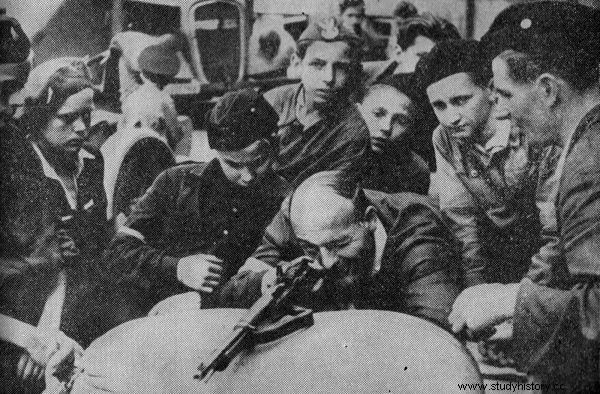
The youngest participants of the Warsaw Uprising while learning how to shoot. Poles had huge problems with the lack of weapons.
Did the Germans know about the Uprising?
It was different with the state of training. Kedyw troops and other available units, seasoned in combat actions, presented a good standard. A large part of the insurgents had the experience of the September campaign behind them. The remaining units have not yet had the opportunity to take part in a real fight. The fact that the Germans had been expecting the outbreak of the Uprising for a long time worked to the detriment of the Home Army.
As the German historian of the Uprising, Hans von Krannhals, writes in his book Powstanie Warszawskie 1944, recently translated into Polish, the German security services reported on Polish preparations for the speech, they also knew the exact date and time. On August 1, 1944, in the war journals of the 9th Army and Army Group "Center" it was almost relieved:"The expected [emphasis by the author] of the Polish uprising has begun." So there was no common surprise at all - we read from Krannhals.
Like in Stalingrad and Berlin
Despite the above-mentioned difficulties (and there were also others:poor communication, lack of ammunition, lack of coordination with the Allies, etc.), the insurgent troops were able to successfully resist the Germans for over two months of operations. Calculated for a few days, the performance turned into heavy urban fights, with a scale of fierce comparable by historians to those in Stalingrad and Berlin. The Home Army soldiers compensated for the deficiencies in armament, training, supplies and communications with commitment, mobility, resourcefulness and high morale.
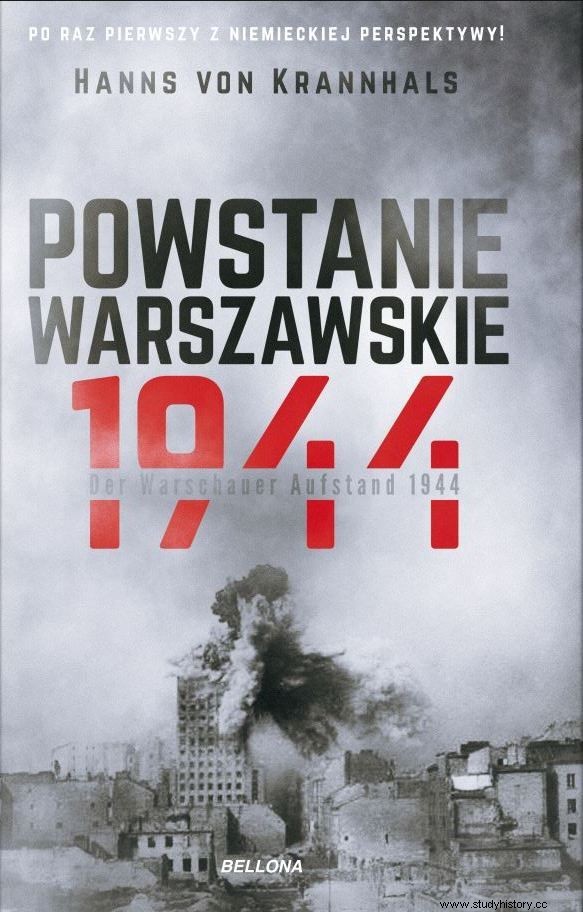
The article was inspired by Hanns von Krannhals' book "Powstanie Warszawskie 1944", in which the author reveals, among other things, the unknown background of Nazi crimes against the civilian population of Warsaw.
The commanders of the insurgent units quickly learned to fight in the new conditions and perfected their tactics, often surprising the Germans. A stratagem was used, assault groups were created to attack important targets and consist of the best armed and trained units. They also used other, classic principles of the art of war by surprise, showing initiative (including pre-emptive actions), maneuverability, cooperation and maintaining combat capability until the end - wrote a historian who researched the military side of the Uprising, prof. Krzysztof Komorowski.What were the losses?
As a result, for 63 days, the insurgents tied 20-40 thousand people. Germans (according to the aforementioned professor Krzysztof Komorowski), which corresponded to several large military units. By temporarily blocking the Warsaw communication junction, they made provisioning and replenishment at the front difficult. The suppression of the Uprising turned out to be surprisingly difficult for the Germans and cost them a lot of resources, effort and losses in people and equipment. How great were the losses suffered by the Germans? Did the insurgents manage to eliminate many enemy soldiers?
General von dem Bach is shooting
On October 5, 1944, General Erich von dem Bach, who led the suppression of the Uprising, prepared for the superior Final report from the fights in Warsaw. In item 7, he specified his own losses:
Fallen:73 officers, 1,453 NCOs and privates. A total of 1526 (+44 foreigners). Wounded:242 officers, 7,054 non-commissioned officers and privates. Total:8196 (+178 foreigners).
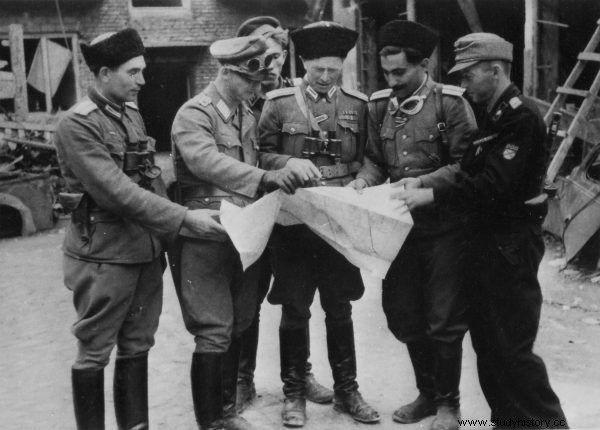
Representatives of other nations also fought on the German side in the Warsaw Uprising. In the photo, Major Ivan Frolov consults with officers of RONA - the army of Russian collaborators.
So in total, taking into account the above-mentioned foreigners (i.e. Russians, Ukrainians, Azeris and others serving in collaborative units), 1570 were killed on the German side, and 8374 soldiers were wounded.
In turn, after the war, in February 1947, von dem Bach was interrogated in Poland in the trial of one of the war criminals. Then he made an extensive report on the Uprising. We read in it, among others:
As far as own losses are concerned, their amount can only be approximated as it was not possible to check the reports of the surrounding part of the units. The approximate estimates are as follows:
- 10,000 dead,
- 7,000 missing,
- 9,000 wounded .
In total, the Germans were to lose as many as 17,000 in the battles in and around Warsaw. people.

SS men on the site of the tenement house at Focha 9.
The number has a life of its own
Von dem Bach's testimony was published in 1947 in the periodical "Dzieje Latest", and from there it found its way to scientific and popular science literature. Thus, the number of 17 thousand. Germans killed and missing in the Uprising gained a source foundation and began to live their own life. The more that it was supported by the data included in the so-called the Gehlen report.
In April 1945, Gen. Reinhard Gehlen, head of the Foreign Armies East section of the General Staff of the Land Forces, responsible for gathering information about the Red Army, prepared a comprehensive report on the Polish underground for the most important persons of the Third Reich. In it, he described with knowledge the structure and activity of the Home Army and the Polish Underground State, adding from himself many interesting conclusions and observations. He devoted as many as 20 typescript pages to the Warsaw Uprising. He wrote there that the German losses were to be 10,000. killed, 6 thousand missing and 9 thousand. injured. As you can see his data does not differ much from those given in 1947 by von dem Bach.
There were also other estimates of German losses. In the last days of the Uprising, an officer of the 3rd Operational Division of the Staff of the Home Army Headquarters, Lieutenant Colonel Felicjan Majorkiewicz "Iron" calculated the German losses at 10-12 thousand zlotys. killed and wounded. Similar figures were provided by Mała Encyklopedia Powszechna from 1959 - 12 thousand. fallen and wounded.
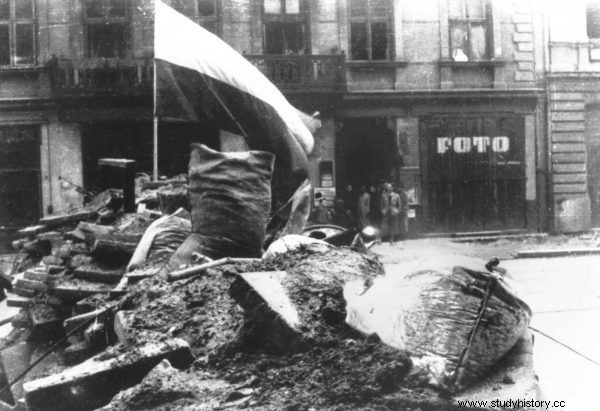
About 16,000 of its participants died in the Warsaw Uprising. The photo shows the barricade on Marszałkowska Street.
The general didn't say that…
The dominant number of 17 thousand. killed and missing in the Uprising on the German side has long functioned in Polish literature and journalism. As stated by the military historian Norbert Bączyk, von dem Bach's account of "The History of the Newest" was taken for granted and became a permanent part of the historiography of the Uprising. Meanwhile, some historians have pointed out that there are many distortions in this document, as shown by careful analysis of the whole.
Some of the quotes attributed to von dem Bach could not have been his own. The statements that fit the propaganda narrative were probably fabricated. This happened, among others, with those with the amount of German losses in the Uprising. Let us give the floor to the aforementioned Norbert Bączyek once again:
For ideological reasons, the German losses had to exceed the losses of the insurgent soldiers (...). In this testimony, the Germans have more killed, wounded and missing than the insurgents, together as many as 17,000. permanently eliminated and 9 thous. injured.
Let us add that the data from von dem Bach's account was also questioned in 1958 by a military historian and researcher of the Warsaw Uprising, General Jerzy Kirchmayer.
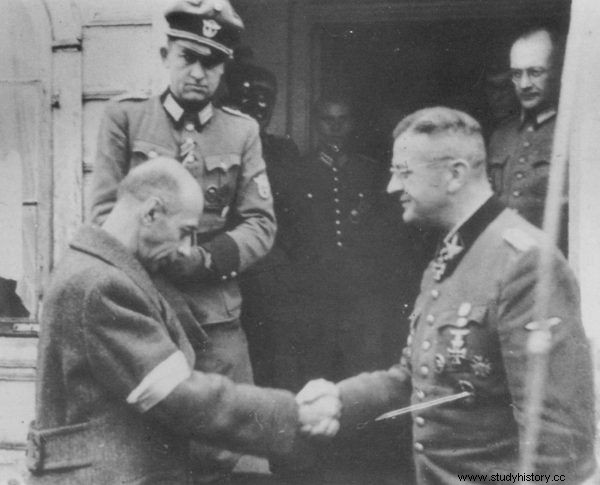
General Tadeusz Bór-Komorowski shakes the hand of SS-Obergrupenführer Erich von dem Bach in his quarters in Ożarów Mazowiecki, October 1944. General von dem Bach had Polish roots, formerly his surname was von dem Bach-Zelewski.
Rather 2,000 were killed
So what about the Gehlen report? In this case, there was rather an error in reading it correctly. As he stated in the book Battle for Warsaw '44 the already mentioned prof. Krzysztof Komorowski, the report was based on the reports of the Korpuśna von dem Bach Group and the 9th Field Army. However, it should be assumed that the data provided therein covered all losses incurred by the Germans near Warsaw, including those sustained with the Soviet troops and in the battles for Praga. The historian then writes: However, in strictly anti-insurrection activities, von dem Bach's information, estimating it at 2,000, seems to be more credible. killed and 9 thousand. wounded and 100-200 dead civilians.
This number is also supported by Hans von Krannhals, known for his solid approach to research. In his book he wrote:
Due to the overestimation of German losses by Bach-Zelewski, who, with numbers of 10,000 dead, 7,000 missing and 6,000 wounded, significantly overestimated the data from his own loss reports made during the uprising , this information also found its way into Polish literature. The documents of the 9th Army do not contain the balance of losses during the fight against the Warsaw Uprising. However, on the basis of partial reports of August 29, 1944 and September 18, 1944, it can be calculated with great probability that 2,000 soldiers commanded by German units died during the uprising on the German side, and 9,000 were wounded.
It includes German losses from the first day of the uprising and those shot in Polish captivity, as well as missing soldiers from German units. In addition, there are at most 100-200 German civilians who fell into the hands of the Poles at the beginning of the fights and are considered murdered .
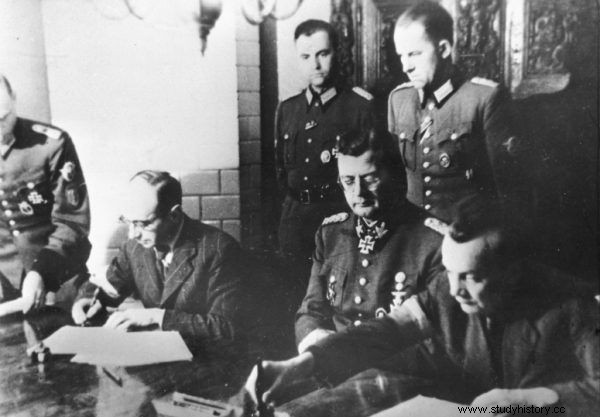
Signing of the "Treaty on the cessation of hostilities in Warsaw", October 3, 1944. General von dem Bach is in the center, and two insurgents are sitting next to him:on the left Colonel Kazimierz Iranek-Osmecki "Heller", on the right Lieutenant Colonel Zygmunt Dobrowolski "Zyndram".
The above-mentioned civilians (mainly Volksdeutsche) were most likely killed out of revenge by the people of the capital. Regarding the killing of prisoners, General "Monter" commented on the briefing with commanders on August 1, which allowed for the liquidation of policemen, SS men, gendarmes and Gestapo men. Wehrmacht soldiers surrendering were to be treated as full-fledged prisoners.
A task for historians
It's hard to say what the German losses in the Warsaw Uprising really were. Until we see a meticulous analysis of all German documents (reports, reports, summaries) produced by units, structures and commands that participated in the suppression of the Uprising, the most likely numbers seem to be the one given by Krzysztof Komorowski and Hans von Krannhals:about 2,000 dead, 9,000 wounded and 100-200 murdered civilians.
Check where to buy the book:"Powstanie Warszawskie 1944":
